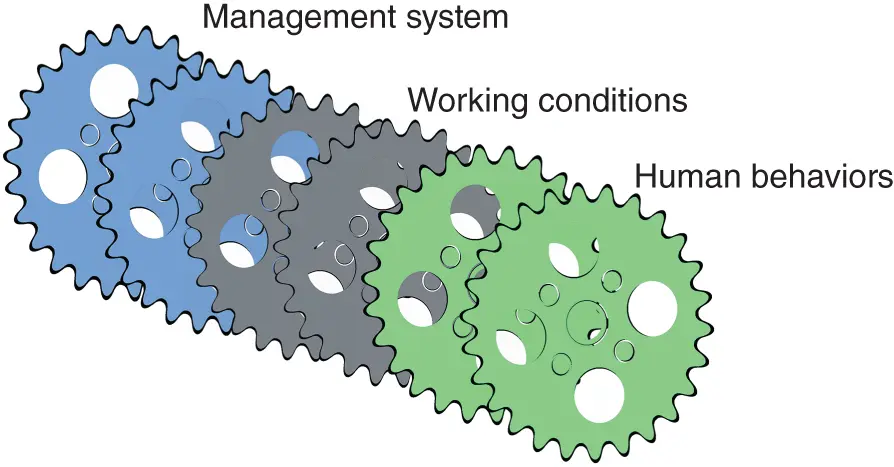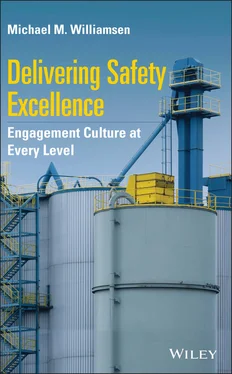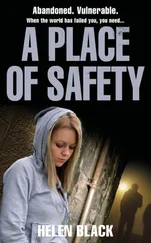Over time I have been faced with a few new OSHA directors who view themselves as “The new sheriff in town.” A common thread of the new sheriff is a promise to punish industries as their way to safety success. At the end of their term I have had difficulty seeing any real statistical difference in safety performance. Since the 1970s there have been incredible continuous improvements in multiple technologies worldwide which have delivered amazing performance improvements in just about all that we experience and do. That is except in safety, where the old, tired, low performing approach of the seventies remains the outdated norm. Continuing the beatings, which have proven to be unsuccessful in improving safety performance, is a kind of leadership (either governmental or industrial) insanity which needs to be changed. Doing the same thing and expecting different results just does not make sense.
As Aaron reflects on the above safety culture reality of his company, he has also reached the conclusion that the union which represents the workers is a part of the poor safety performance culture where he works. They are safety complacent too because of a good technology apprentice program, no critical injuries for a number of years (except for now), and a good company medical benefits system which pays for fixing the injured employees and gets them back to the job. However, in Aaron's company there is a huge separation/gap between frontline employees and upper management. The high injury rate, a lack of caring, along with a focus on punishment with no real action by management, has become an angry boil that keeps the safety department as the object of festering unhappiness by all.
The general feeling across the organization is that: this is a great place to live; the pay is good; the work is not all that hard; and the frontline employees are well trained, highly skilled and have a good work ethic. However, the huge gap and lack of respect between the frontline employees and management have morale in the tank and skilled frontline employees leaving for other companies who need their skills and have a better culture.
Aaron realized doing the same thing and expecting a different result just does not make sense. But he is up from the ranks with little safety background and his upper management just does not seem to care or want to get involved in anything that is troubling. There is no apparent silver lining in the dark foreboding clouds surrounding the safety reality. He reflects on the safety filter 3 discussion he had with the Doc.

Figure 1.1Work on the job site.
Source: Reason, James (1990). The contribution of latent human failures to the breakdown of complex systems. Philosophical Transactions of the Royal Society of London. Series B, Biological Sciences . 327(1241): 475–484.
Safety systems have barriers (filters) which help prevent injuries and incidents. These include management systems, working conditions, and human behaviors. In a 24/7 operation, or any other for that matter, these filter plates are spinning as the work dynamic and process relentlessly continue. However, each filter piece has some holes (weaknesses) in it, and when the spinning holes line up, an incident occurs. When someone is in the wrong place, at this wrong time of weakness alignment, an incident (near miss/close call) or an injury (hit) also occurs. Aaron realizes that his employing organization has way too many holes in its safety barrier filters.
He remembers his friendship with an excellent skier, Tim, who gave him a great lesson in the facts of achieving performance greatness. Tim loves skiing moguls and by his own standards is “pretty darn good at it.” In an effort to improve his abilities, he paid for coaching from a professional skier. Much to Tim's chagrin the pro's evaluation of his “pretty darn good” technique and ability came back as “a closely linked series of recoveries.” They had a good laugh, and then discussed another acquaintance who decided to become a pro golfer even though he never really played golf until later in life. His professional coach advised a need for 10 000 hours of concentrated practice to raise his skills to a point where he could make a valid decision, whether or not “to continue to try and become a pro golfer.”
Tim and Aaron reached some conclusions out of their dialogues about professional performance. You need dedication, practice, drive, ability, good technique, and a relentless pursuit of excellence to even come close to the execution levels of professionals. These dedicated professionals are able to daily achieve measures accomplished by only the best of the best. Or in street language; “My commitment is stronger than a bumper sticker, but less than a tattoo” is just not good enough to get anywhere near great results.
Is there any parallel in safety performance? You bet! Those organizations which routinely go years without lost time or medical incidents have a leading edge engagement culture that has their entire organization focused on dedication, practice, drive, technique, and daily safety leadership development at all levels. This kind of safety culture delivers an end result which visibly demonstrates a relentless pursuit of zero errors (incidents). Every day they practice and live models of process excellence in operations AND safety. They are always in search of ways to improve their performance in every aspect of what they do, including safety. They do the fundamentals well and then go way beyond the basics. The rest of the pack of safety professional wannabes, who have safety cultures that are pretty darn good, seem to just live a culture where there is a closely linked series of recoveries instead of emphasizing a culture of prevention excellence.
Aaron racks his brain. It all seems so hopeless. He begins to dig deeper on many of the other road blocks that stand in his way of stopping the injuries of his friends in the field. Aaron needs to make a choice: “Never, never, never give up” thank you very much Winston Churchill or “When you wake up tomorrow you will still be ugly.”
1 1 RIF Recordable Injury Frequency ([number of injuries requiring medical/doctor treatment] x 200 000) divided by total hours worked.
2 2 The Voluntary Protection Programs (VPP) recognize employers and workers in the private industry and federal agencies who have implemented effective safety and health management systems and maintain injury and illness rates below national Bureau of Labor Statistics averages for their respective industries.
3 3 James Reason (2000) proposed the image of “Swiss cheese” to explain the occurrence of system failures, such as medical mishaps. According to this metaphor, in a complex system, hazards are prevented from causing human losses by a series of barriers. Each barrier has unintended weaknesses, or holes – hence the similarity with Swiss cheese. These weaknesses are inconsistent, i.e. the holes open and close at random. When by chance all holes are aligned, the hazard reaches a person and causes harm.
4 4 This additional publication material is “Reason, James (1990). The contribution of latent human failures to the breakdown of complex systems. Philosophical Transactions of the Royal Society of London. Series B, Biological Sciences. 327(1241): 475–484”.
The week after the funeral Aaron tries to de‐stress by going out to dinner with his wife. As he sits down the images of the funeral, the fellow workers, the widow… flood into his mind. As he crumples into the chair, internal emotion erupts and he bangs his head repeatedly on the table. Finally, he gets back into some small level of mental control, but couldn't eat. They apologize to the waiter, and Aaron's wife drives toward home as he struggles with the impossible task staring him in the face: neither management nor labor is willing to do anything to improve their miserable safety record. Sure, there is no lack of talking heads and condemnation on both sides. However, a decade of complaining without any substantial actions has delivered absolutely nothing (no improvement) to any real safety culture or employee injury reduction .
Читать дальше













